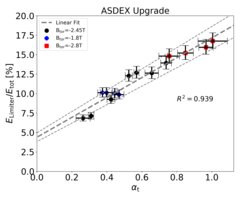Investigation of the heat load on the first wall in ASDEX Upgrade for ITER scenarios
Turbulence at the plasma edge is advantageous for material-friendly power dissipation. It suppresses excessively steep temperature and density profiles at the plasma edge and thus avoids undesired instabilities, so-called edge localised modes (ELMs).
In this way, the dissipated energy is distributed over a larger area. In order to make reliable predictions for ITER, the heat load on the first wall was measured with high accuracy using cooling water calorimetry and optimised plasma experiments. It could be worked out that the strength of the heat load correlates very well with the turbulence control parameter αt, which was derived from theoretical considerations. αt is a newly introduced parameter that describes the degree of turbulence at the separatrix.

The figure depicts this correlation: the x-axis shows the measured αt-value, the y-axis the strength of the heat load at the first wall. The wall load is normalised by the total sum of the calorimetrically recorded energy and given here as a percentage. As can be seen from the figure, low-density H-modes with ELMs (αt < 0.2) result in about 6 % of the energy at the first wall and preferential high-density ELM-free discharges with strong turbulent transport (αt > 0.8) in about 16 %. The measurements presented here are in good agreement with the estimation of a previous study.
For the use of such high-density ELM-free plasmas in ITER or future fusion reactors, this additional thermal loading of the first wall has to be taken into account to allow a material-conserving design of the wall components.
The publication on this work can be found here: A. Redl et al., Energy load on first wall components in high density small ELM regimes in ASDEX Upgrade, Nuclear Materials and Energy 34, 101319 (2023)
